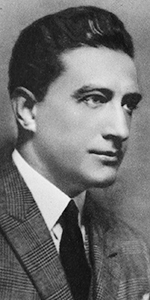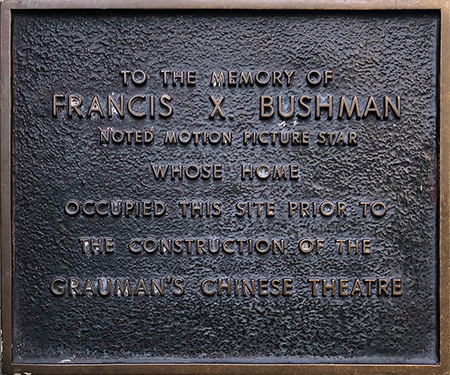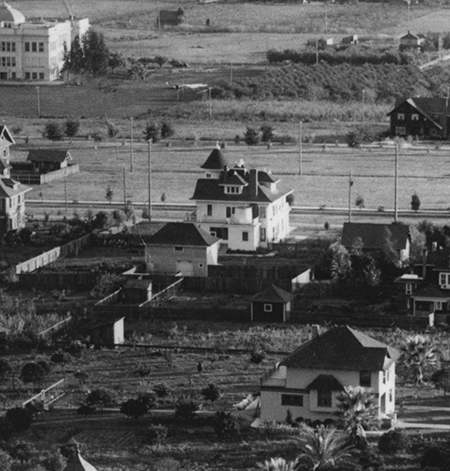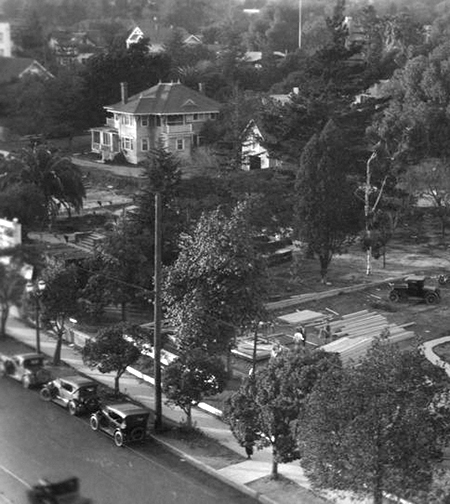 |
 |
 |
 |
 |
| Francis X. Bushman, date unknown. |
| |
|
 |
|
 |
| |
 |
| |
 |
| |
 |
| |
 |
| |
|
|
| Francis X. Bushman Plaque
|
 |
| Forecourt Ceremony held on Tuesday, November 17, 1970 |
| |
Born: January 10, 1883, in Baltimore, Maryland
Died:
August 23, 1966, in Pacific Palisades, California, age 83
|
| |
Francis X. Bushman was a leading man in the silent era. Dashing and good-looking, Bushman's career peaked with his playing the heavy, Messala, in the 1925 silent version of Ben-Hur.
Born in Balitimore Maryland, Bushman attended Ammendale College. The life of the artistic world appealed to him and during his youth, he spent time as a wrestler, a boxer, a bicycle racer, and an artist's model. An extremely fit (for his day) specimen, he took to the stage, finding his way to Chicago Illinois, home of the Essanay studio who put him right to work:
His Friend's Wife (released in June 1911), with Lottie Briscoe was his first film there.
He made
27 short films that year, with titles like: The Gordian Knot (released in August 1911), with Dorothy Phillips, Putting It Over (released in September 1911), with Dorothy Phillips, and Too Much Turkey (released in November 1911), with Walter F. Scott.
The first feature Bushman headlined in was called Graustark (released in April 1915) with Beverly Bayne, whom he married in 1918 after divorcing his first wife. Signing with Metro Pictures, Bushman's first feature was one of the newly formed studio's earliest releases: The Second in Command (released in July 1915) with Margerite Snow.
To give an idea of how busy Metro kept this actor, one need only consider that, in 1916, he starred in eight features, including starring in and co-directing a version of Romeo and Juliet (released in October 1916), with Beverly Bayne as Juliet; five features in 1917, and seven in 1918. The purchase of Metro by theatre magnate Marcus Loew slowed Bushman's career. As forces combined to form Metro-Goldwyn-Mayer, Bushman only starred in two films in 1922. The next year brought only Modern Marriage (released in April 1923), with Beverly Bayne, which the couple produced and released themselves.
Since Bushman was on the outs with both Loew and Mayer, Bushman's agent, Harry Reichenbach schemed to get his client to play the Messala character in what would probably be the biggest film (and hit) of the silent era:
Ben-Hur: A Tale of the Christ (released in December, 1925), with Ramon Navarro. Bushman is strangely compelling in this film.
Bushman felt that after Ben-Hur, he had been blackballed by M-G-M president Louis B. Mayer. With money tight, he decided to downsize by selling his large home on Hollywood Boulevard to real estate mogul C.E. Toberman, head of a sysndicate formed to construct Grauman's Chinese Theatre. The house was pulled down, and construction began in early 1926, with Bushman moving to a smaller house in Whitely Heights, and then Pacific Palisades.
Still on the outs at M-G-M, Bushman starred in The Marriage Claus (released in September 1926), with Billie Dove, at Universal. Several more films followed; his first talkie was an independent affair: Call of the Circus (released in January 1930), with Ethel Clayton. Work slowed to a trickle. He had a bit part as a director in Hollywood Boulevard (released in August 1936), then played a police chief in the first version of the comic strip Dick Tracy (released in February 1937), with Ralph Byrd in the title role. Bushman managed to sneak back into M-G-M for the Judy Garland musical Thoroughbreds Don't Cry (which played the Chinese in December 1937).
Bushman played philanthropist and economic advisor Bernard Baruch in the ill-fated biopic Wilson (released in August 1945), and played King Saul in David and Bathsheba (which played the Chinese in August 1951). Now no longer a studmuffin, Bushman settled into playing old fogies, such as a minister in The Bad and the Beautiful (released in December 1952), Martha Hyer's rich dad in Sabrina (released in October 1954, and Moses in the Irwin Allen flick The Story of Mankind (released in November 1957).
Television came calling. Bushman had parts as a doctor on The Adventures of Ozzie and Harriet aired over ABC in April 1958, a traffic court judge on Make Room for Daddy aired over CBS in October 1959, an alcoholic old-time actor making a comback on
Peter Gunn aired over ABC in May 1961.
Bushman still got the occasional part in films, like playing the leader of a distant planet in The Phantom Planet (released in December 1961).
In 1962, the women members of the Hollywood Chamber of Commerce began a campaign to commemorate the site of Bushman's home with a plaque somewhere in the Forecourt at Grauman's Chinese. It would take another eight years for it to happen. Meanwhile, Bushman took a part in The Ghost in the Invisible Bikini (released in April 1966), don't worry — he had good company — Basil Rathbone is in it, Boris Karloff is in it, and so is Benny Rubin!
Bushman died of a heart attack at the age of 83 at his home in Pacific Palisades, in August 1966. His final work appeared posthumously, on an episode of Voyage to the Bottom of the Sea aired over ABC in October 1966.
It wasn't until late 1970 that the plaque was installed in the Forecourt. |
|
|
|
|
| |
 |
 |
| Grauman's Chinese Theatre, Hollywood, California. Francis X. Bushman Plaque. Executed by unknown, Tuesday, November 17, 1970. 12 x 10 inches. |
 |
 |
 |
| Future home of Francis X. Bushman, Hollywood, California, circa 1910. The house is viewed from the north, looking southeast, past Hollywood Boulevard, toward Hollywood High School. Photo courtesy of Marc Wannamaker / Bison Archives. |
|
 |
 |
 |
| Future site of Grauman's Chinese Theatre, Hollywood, California, probably late 1925. The area in the center is where the Bushman house was (the front steps may still be seen). Construction of the hoarding, or temporary fence has begun. |
|